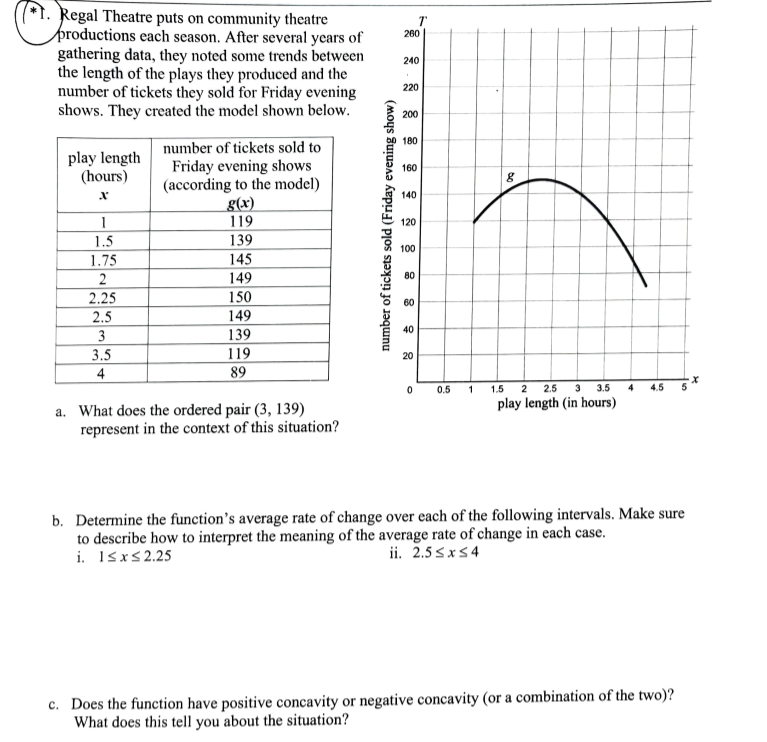*1. Regal Theatre puts on community theatre þroductions each season. After several years of gathering data, they noted some trends between the length of the plays they produced and the number of tickets they sold for Friday evening shows. They created the model shown below. 260 240 220 200 number of tickets sold to Friday evening shows (according to the model) _g(x) 119 180 play length (hours) 160 140 120 1.5 139 100 145 149 1.75 80 2 2.25 150 60 2.5 149 40 139 119 3 3.5 20 4 89 2.5 3 play length (in hours) 0.5 1 1.5 2 3.5 4 4.5 a. What does the ordered pair (3, 139) represent in the context of this situation? b. Determine the function's average rate of change over each of the following intervals. Make sure to describe how to interpret the meaning of the average rate of change in each case. i. Isxs2.25 ii. 2.5 sxs4 number of tickets sold (Friday evening show)
*1. Regal Theatre puts on community theatre þroductions each season. After several years of gathering data, they noted some trends between the length of the plays they produced and the number of tickets they sold for Friday evening shows. They created the model shown below. 260 240 220 200 number of tickets sold to Friday evening shows (according to the model) _g(x) 119 180 play length (hours) 160 140 120 1.5 139 100 145 149 1.75 80 2 2.25 150 60 2.5 149 40 139 119 3 3.5 20 4 89 2.5 3 play length (in hours) 0.5 1 1.5 2 3.5 4 4.5 a. What does the ordered pair (3, 139) represent in the context of this situation? b. Determine the function's average rate of change over each of the following intervals. Make sure to describe how to interpret the meaning of the average rate of change in each case. i. Isxs2.25 ii. 2.5 sxs4 number of tickets sold (Friday evening show)
Functions and Change: A Modeling Approach to College Algebra (MindTap Course List)
6th Edition
ISBN:9781337111348
Author:Bruce Crauder, Benny Evans, Alan Noell
Publisher:Bruce Crauder, Benny Evans, Alan Noell
Chapter3: Straight Lines And Linear Functions
Section3.3: Modeling Data With Linear Functions
Problem 20E: Focal Length A refracting telescope has a main lens, or objective lens, and a second lens, the...
Related questions
Question
part c

Transcribed Image Text:(*1. Regal Theatre puts on community theatre
þroductions each season. After several years of
gathering data, they noted some trends between
the length of the plays they produced and the
number of tickets they sold for Friday evening
shows. They created the model shown below.
260
240
220
200
180
number of tickets sold to
play length
(hours)
Friday evening shows
(according to the model)
g(x)
160
140
1
119
120
1.5
139
100
1.75
145
2
149
80
2.25
150
60
2.5
149
40
3
139
3.5
119
20
4
89
0.5
1
1.5
2
2.5 3
3.5
4
4.5
5
play length (in hours)
a. What does the ordered pair (3, 139)
represent in the context of this situation?
b. Determine the function's average rate of change over each of the following intervals. Make sure
to describe how to interpret the meaning of the average rate of change in each case.
i. Isxs2.25
ii. 2.5 sxS 4
c. Does the function have positive concavity or negative concavity (or a combination of the two)?
What does this tell you about the situation?
number of tickets sold (Friday evening show)
Expert Solution
This question has been solved!
Explore an expertly crafted, step-by-step solution for a thorough understanding of key concepts.
Step by step
Solved in 3 steps

Knowledge Booster
Learn more about
Need a deep-dive on the concept behind this application? Look no further. Learn more about this topic, calculus and related others by exploring similar questions and additional content below.Recommended textbooks for you

Functions and Change: A Modeling Approach to Coll…
Algebra
ISBN:
9781337111348
Author:
Bruce Crauder, Benny Evans, Alan Noell
Publisher:
Cengage Learning

Algebra & Trigonometry with Analytic Geometry
Algebra
ISBN:
9781133382119
Author:
Swokowski
Publisher:
Cengage

Functions and Change: A Modeling Approach to Coll…
Algebra
ISBN:
9781337111348
Author:
Bruce Crauder, Benny Evans, Alan Noell
Publisher:
Cengage Learning

Algebra & Trigonometry with Analytic Geometry
Algebra
ISBN:
9781133382119
Author:
Swokowski
Publisher:
Cengage